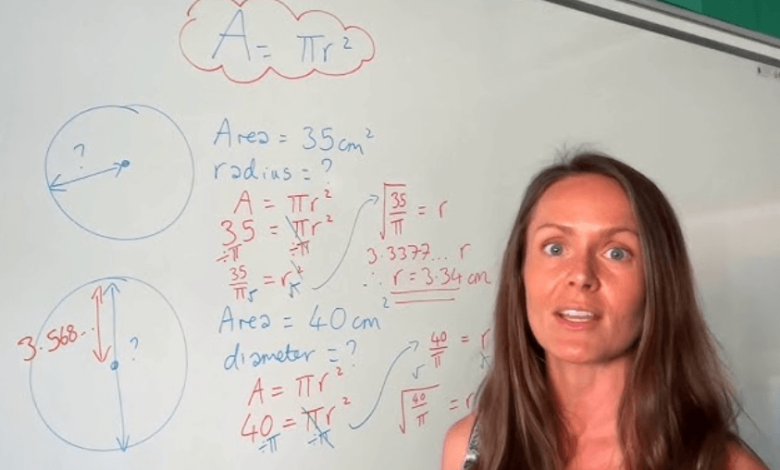Calculating Circle Area Using Diameter

When studying geometry, circles are among the most common shapes you’ll encounter. While most people learn how to find a circle’s area using its radius, it’s equally possible—and sometimes more practical—to calculate the area using the diameter. In this guide, we’ll explore how to find the area of a circle using diameter, ensuring a full understanding of the concepts and applications behind this useful method.
What Is the Diameter?
The diameter of a circle is the straight-line distance from one point on the edge of the circle to the opposite point, passing through the center. line that fits inside a circle. In mathematical terms:
Diameter (d) = 2 × Radius (r)
That means the radius is simply half of the diameter. This how to find the area of a circle using diameter relationship allows us to adjust the standard formula for finding the area of a circle.
Area Formula Using Radius
The most well-known formula to calculate the area of a circle is:
Area (A) = π × r²
But what if you only know the diameter?
Deriving the Formula Using Diameter
Let’s convert the standard area formula by replacing the radius:
A = π × (d/2)²
A = π × (d² / 4)
So, A = (π/4) × d²
Step-by-Step Calculation
Let’s walk through how to use this formula with real values.
Step 1: Measure the Diameter
Use a ruler, caliper, or measuring tape to find the diameter of the circle. For example, assume the diameter is 12 cm.
Step 2: Square the Diameter
Multiply the diameter by itself:
12 × 12 = 144
Step 3: Multiply by π/4
Now multiply the result by π/4. If using 3.1416 as the value of π:
A = (3.1416 / 4) × 144
A ≈ 0.7854 × 144 = 113.1 cm²
So, the area of a circle with a 12 cm diameter is approximately 113.1 square centimeters.
See also: The Power of General Knowledge Questions
Why Use the Diameter?
In practical situations, it’s often easier to measure the diameter than the radius. For instance, when working with wheels, plates, or pipes, the full width across is usually labeled or more accessible. This is why the diameter-based formula can be more efficient in real-world applications.
Everyday Applications
Understanding how to find the area of a circle using diameter has many practical uses:
Construction
Builders and architects use this method when working with round windows, columns, or decorative structures. Blueprints often specify diameters rather than radii.
Avoiding Common Mistakes
Though the formula is straightforward, errors can still occur. Here’s how to avoid them:
Confusing Radius and Diameter
Be sure you’re using diameter in the correct formula. Using diameter directly in the radius-based formula will give incorrect results unless it’s first divided by 2.
Incorrect Order of Operations
Remember to square the diameter first before multiplying by π/4. Avoid squaring after the π step.
Rounding Too Early
For higher accuracy, use several decimal places of π (3.1416 or even more).
Using Technology
While manual calculations are important for understanding, modern tools make the process quicker:
Scientific Calculators
Most calculators include a π key and exponent key (^2) for squaring. Just input the diameter, square it, and multiply by π/4.
Excel or Google Sheets
You can set up a formula to calculate the area using the diameter. Example formula:
=PI()/4 * A1^2
Where A1 contains the diameter value.
Python Script Example
For programmers, here’s a simple way to compute the area using Python:
import math
diameter = 10
area = (math.pi / 4) * diameter ** 2
print(f”The area is {area}”)
This approach can be scaled to handle hundreds of calculations instantly.
Real-World Example
Let’s apply this in a real-life situation. Suppose you’re planning to install circular tiles with a diameter of 30 cm in your backyard. To find the area each tile covers:
A = (π / 4) × 30²
A = 0.7854 × 900
A ≈ 706.86 cm²
If you want to cover 10 square meters (100,000 cm²), you’ll need approximately:
100,000 / 706.86 ≈ 141.5 tiles
So, you would need about 142 tiles to complete the job.
Area Comparison Using Diameter
| Diameter (cm) | Area (cm²) |
| 5 | 19.63 |
| 10 | 78.54 |
| 20 | 314.16 |
| 30 | 706.86 |
| 40 | 1256.64 |
As you can see, doubling the diameter increases the area fourfold, not just double.
Connecting With Other Concepts
The formula (π/4) × d² is useful not just for area, but also when working with circle sectors, circular rings, or annular regions where inner and outer diameters are involved. In such cases, subtracting the area of the inner circle from the outer circle gives the area of the ring:
Area = (π/4) × (D_outer² − D_inner²)
This variation is common in pipe flow calculations and bearing designs.
When to Use Radius Instead
While using diameter is effective, radius-based calculations might be better when:
- Radius is directly available.
- Working with trigonometric circle functions.
- Integrating into other equations involving r.
Still, both methods are interchangeable once you understand their relationship.
Final Thoughts
Mastering how to find the area of a circle using diameter gives you a fast and practical way to solve problems across many disciplines. The formula Area = (π/4) × d² is derived from basic principles and simplifies calculations when diameter is the known value. With real-world relevance in construction, design, science, and daily life, this knowledge empowers you to handle circular measurements confidently and efficiently.
Whether by hand, calculator, spreadsheet, or code, the ability to calculate area using diameter is an essential part of your mathematical toolkit.



